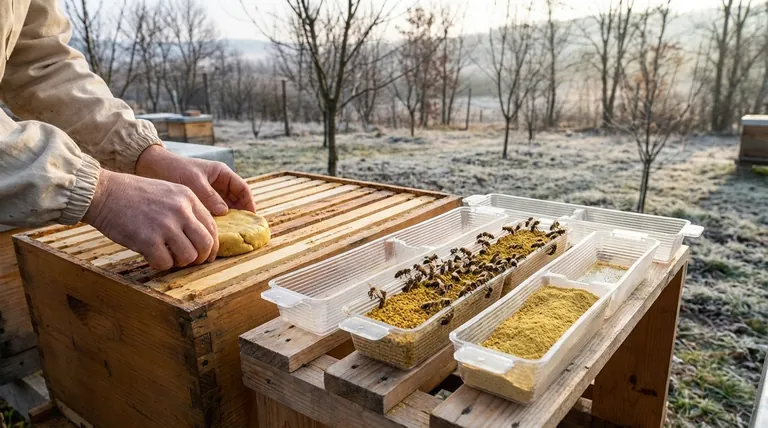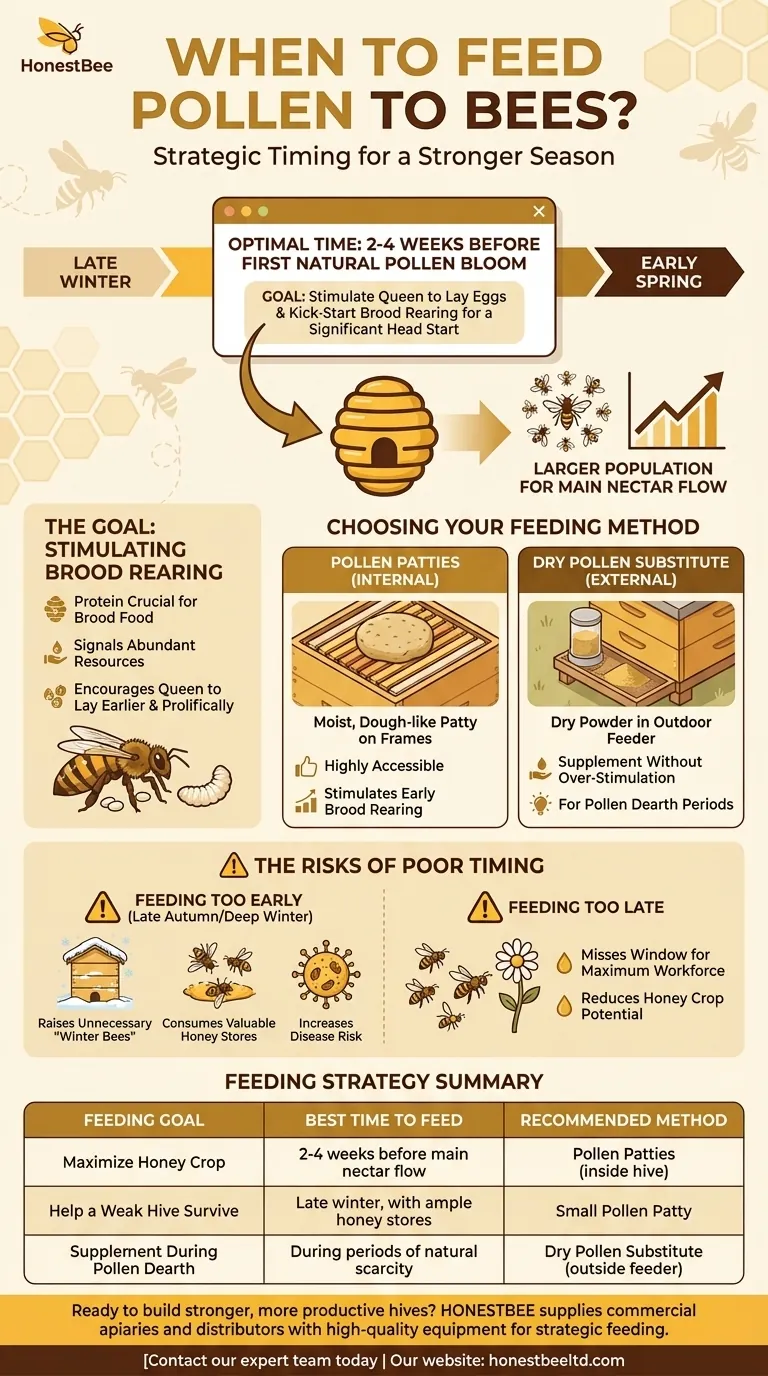The optimal time to feed bees pollen substitute is in late winter or early spring, typically two to four weeks before the first natural pollen-producing plants begin to bloom in your specific area. This strategic timing is designed to stimulate the queen to lay eggs and kick-start brood rearing, giving the colony a significant head start for the season.
Supplemental pollen feeding is a powerful tool for building a strong, populous hive. However, its success hinges entirely on correct timing; feeding too early can waste resources and stress the colony, while feeding too late misses the window to build a maximum-strength workforce for the main nectar flow.

The Goal of Supplemental Feeding: Stimulating Brood Rearing
A beekeeper's decision to feed pollen or a substitute is not about feeding hungry adult bees; it's about providing the necessary protein to raise the next generation.
Why Protein is Crucial
Pollen is the primary source of protein, fats, and minerals for honey bees. This protein is essential for nurse bees to produce the brood food needed to raise larvae into new bees. Without it, brood rearing stops.
Building the Spring Workforce
By providing a pollen substitute before natural sources are available, you signal to the hive that resources are abundant. This encourages the queen to begin laying eggs earlier and more prolifically.
The result is a much larger population of forager bees ready to fly the moment the first major nectar-producing flowers bloom.
The "Head Start" Principle
The core strategy is to have your hive reach its peak population just as the main nectar flow begins. This ensures a maximum workforce is available to collect nectar, which translates directly into a larger honey crop.
Choosing Your Feeding Method
You have two primary forms of supplemental pollen to choose from, each with a different application.
Pollen Patties
Pollen substitute is often mixed with sugar syrup to form a moist, dough-like patty. These patties are placed directly on top of the frames inside the hive.
This internal placement makes the food highly accessible to the bees, regardless of outside weather conditions, and is the most common method for stimulating early brood rearing.
Dry Pollen Substitute
The substitute can also be offered as a dry powder in a feeder outside the hive. Bees will collect it just as they would natural pollen.
This method is typically used when you want to offer supplemental protein but without over-stimulating the hive, or during periods of natural pollen dearth.
Understanding the Trade-offs: The Risks of Poor Timing
While beneficial, poorly timed supplemental feeding can do more harm than good. Your local climate and floral calendar are your most important guides.
The Danger of Feeding Too Early
Feeding in late autumn or deep winter is a common and costly mistake. This encourages the colony to raise new "winter bees" that have no work to do.
These unnecessary bees consume valuable honey stores and may be forced to defecate inside the hive during periods of cold weather when cleansing flights are impossible, increasing disease risk.
The Risk of Introducing Disease
If you choose to feed natural pollen instead of a substitute, it is critical to source it from a highly reputable supplier. Pollen collected from unknown hives can be a vector for introducing serious brood diseases, such as American Foulbrood, into your colony.
For this reason, most beekeepers opt for commercially produced, soy-based pollen substitutes, which are safer and more cost-effective.
Making the Right Choice for Your Hive
Use your specific goals to determine your feeding strategy.
- If your primary focus is maximizing the honey crop: Begin feeding pollen patties 2-4 weeks before the first major nectar flow is expected in your area to build a massive forager population.
- If your primary focus is helping a weak hive survive: Provide a small patty in late winter, but only if they have abundant honey stores to support the new brood.
- If you are in an area with a pollen dearth: Provide a dry pollen substitute in an outdoor feeder to supplement their diet without forcing brood production beyond what the hive can support.
By aligning your feeding schedule with the hive's natural cycle, you can effectively direct its growth for a stronger and more productive season.
Summary Table:
| Feeding Goal | Best Time to Feed | Recommended Method |
|---|---|---|
| Maximize Honey Crop | 2-4 weeks before the main nectar flow | Pollen Patties (inside hive) |
| Help a Weak Hive Survive | Late winter, with ample honey stores | Small Pollen Patty |
| Supplement During Pollen Dearth | During periods of natural scarcity | Dry Pollen Substitute (outside feeder) |
Ready to build stronger, more productive hives?
HONESTBEE supplies commercial apiaries and beekeeping equipment distributors with the high-quality, reliable supplies needed for strategic feeding and hive management. From durable pollen patty molds to efficient feeders, our wholesale-focused operations ensure you get the equipment that supports optimal colony growth.
Contact our expert team today to discuss your beekeeping supply needs and boost your season's success!
Visual Guide

Related Products
- In-Hive Dual Compartment Frame Bee Feeder for Targeted Colony Nutrition
- Premium Wood Framed Metal Wire Queen Bee Excluder
- Plastic Queen Bee Excluder for Bee Hive Wholesale
- Wooden Queen Bee Excluder for Beekeeping
- Professional Galvanized Hive Strap with Secure Locking Buckle for Beekeeping
People Also Ask
- What are the benefits of feeding bees inside the hive? Maximize Colony Health & Security
- What precautions should be taken when feeding bees inside the hive? Safeguard Your Colony from Robbing and Leaks
- What are frame feeders, and what are their advantages? Essential for Cold Weather & Efficient Feeding
- What are division board feeders? Essential Tools for Safe and Effective In-Hive Feeding
- How does the internal feeder method work? Protect Your Hive from Robbing and Cold



















